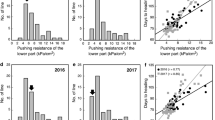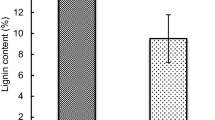Abstract
Culm strength deterioration from grain filling to the fully ripe stage is one of the main causes of rice lodging. The quantitative trait locus for resistance to bending-type lodging, BSUC11, prevents upper culms from deteriorating their physical strength. The physical strength of culms is determined by morphological traits and chemical components. To clarify key factors preventing strength deterioration of culms after grain filling, this study conducted functional analyses on morphological traits and chemical components of upper culms using chromosomal segment substitution lines (CSSLs) containing BSUC11. Dry weights of upper culms in CSSLs with BSUC11 were heavier than those of ‘Koshihikari’ from 4 to 6 weeks after heading. For morphological traits at the fully ripe stage, CSSLs with BSUC11 only showed a thickening of cortical fiber tissues in internode I, and did not have greater diameter or wall thicknesses of upper culms. Additionally, the upper culms of CSSLs with BSUC11 increased holocellulose content instead of lignin, nonstructural carbohydrates, or minerals compared with ‘Koshihikari’. These results suggest that culm strength deterioration after grain filling is contributed to by holocellulose content rather than morphological traits in rice culms, and BSUC11 could improve lodging resistance through prevention of this deterioration factor.



Similar content being viewed by others
References
Ando T, Yamamoto T, Shimizu T, Ma XF, Shomura A, Takeuchi Y, Lin SY, Yano M (2008) Genetic dissection and pyramiding of quantitative traits for panicle architecture by using chromosomal segment substitution lines in rice. Theor Appl Genet 116:881–890
Ashikari M, Sakakibara H, Lin S, Yamamoto T, Takashi T, Nishimura A, Angeles ER, Qian Q, Kitano H, Matsuoka M (2005) Cytokinin oxidase regulates rice grain production. Science 309:741–745
Atkins IM (1938) Relation of certain plant characters to strength of straw and lodging in winter wheat. J Agric Res 56:99–120
Bergmeyer HU, Bernt E (1974) Methods for determination of metabolites: carbohydrate metabolism: sucrose. In: Bergmeyer HU (ed) Methods of enzymatic analysis 3. Academic Press, New York, pp 1176–1179
Campbell MM, Sederoff RR (1996) Variation in lignin content and composition. Plant Physiol 110:3–13
Ebitani T, Takeuchi Y, Nonoue Y, Yamamoto T, Takeuchi K, Yano M (2005) Construction and evaluation of chromosome segment substitution lines carrying overlapping chromosome segment of indica rice cultivar “Kasalath” in a genetic background of japonica elite cultivar “Koshihikari”. Breed Sci 55:65–73
Flintham JE, Börner A, Worland AJ, Gale MD (1997) Optimizing wheat grain yield: effects of Rht (gibberellin-insensitive) dwarfing genes. J Agric Sci 128:11–25
Hirano K, Kotake T, Kamihara K, Tsuna K, Aohara T, Kaneko Y, Takatsuji H, Tsumuraya Y, Kawasaki S (2010) Rice BRITTLE CULM 3 (BC3) encodes a classical dynamin OsDRP2B essential for proper secondary cell wall synthesis. Planta 232:95–108
Hirano K, Okuno A, Hobo T, Ordonio R, Shinozaki Y, Asano K, Kitano H, Matsuoka M (2014) Utilization of stiff culm trait of rice smos1 mutant for increased lodging resistance. PLoS ONE 9:e96009
Idris MD, Hossain MM, Choudhury FA (1975) The effect of silicon on lodging of rice in presence of added nitrogen. Plant Soil 43:691–695
Ishimaru K, Yano M, Aoki N, Ono K, Hirose T, Lin SY, Monna L, Sasaki T, Ohsugi R (2001) Toward the mapping of physiological and agronomic characters on a rice function map: QTL analysis and comparison between QTLs and expressed sequence tags. Theor Appl Genet 102:793–800
Ishimaru K, Togawa E, Ookawa T, Kashiwagi T, Madoka Y, Hirotsu N (2008) New target for rice lodging resistance and its effect in a typhoon. Planta 227:601–609
Kashiwagi T (2014) Identification of quantitative trait loci for resistance to bending-type lodging in rice (Oryza sativa L.). Euphytica 198:353–367
Kashiwagi T, Ishimaru K (2004) Identification and functional analysis of a locus for improvement of lodging resistance in rice. Plant Physiol 134:676–683
Kashiwagi T, Hirotsu N, Madoka Y, Ookawa T, Ishimaru K (2007) Improvement of resistance to bending-type lodging in rice. Jpn J Crop Sci 76:1–9
Kashiwagi T, Togawa E, Hirotsu N, Ishimaru K (2008) Improvement of lodging resistance with QTLs for stem diameter in rice (Oryza sativa L.). Theor Appl Genet 117:749–757
Kashiwagi T, Shindoh K, Hirotsu N, Ishimaru K (2009) Evidence for separate translocation pathways in determining cadmium accumulation in grain and aerial plant parts in rice. BMC Plant Biol 9:8
Khush GS (1999) Green revolution: preparing for the 21st century. Genome 42:646–655
Kokubo A, Kuraishi S, Sakurai N (1989) Culm strength of barley. Correlation among maximum bending stress cell wall dimensions, and cellulose content. Plant Physiol 91:876–882
Kokubo A, Sakurai N, Kuraishi S, Takeda K (1991) Culm brittleness of barley (Hordeum vulgare L.) mutant is caused by smaller number of cellulose molecules in cell wall. Plant Physiol 97:509–514
Kono M, Takahashi J (1964) Study on the mechanical properties of paddy culm with reference to lodging. Soil Sci Plant Nut 10:239–249
Kotake T, Aohara T, Hirano K, Sato A, Kaneko Y, Tsumuraya Y, Takatsuji H, Kawasaki S (2011) Rice Brittle culm 6 encodes a dominant-negative form of CesA protein that perturbs cellulose synthesis in secondary cell walls. J Exp Bot 62:2053–2062
Li Y, Qian Q, Zhou Y, Yan M, Lei Sun, Zhang M, Fu Z, Wang Y, Han B, Pang X, Chen M, Li J (2003) BRITTLE CULM1, which encodes a COBRA-like protein, affects the mechanical properties of rice plants. Plant Cell 15:2020–2031
Li X, Yang Y, Yao J, Chen G, Li X, Zhan Q, Wu C (2009) FLEXIBLE CULM1 encording a cinnamyl-alcohol dehydrogenase controls culm mechanical strength in rice. Plant Mol Biol 69:685–697
Ma QH (2009) The expression of caffeic acid 3-O-methyltransferase in two wheat genotypes differing in lodging resistance. J Exp Bot 60:2763–2771
Ma JF, Yamaji N (2006) Silicon uptake and accumulation in higher plants. Trends Plant Sci 11:392–397
Ma JF, Tamai K, Ichii M, Wu GF (2002) A rice mutant defective in Si uptake. Plant Physiol 130:2111–2117
Matsuda T, Kawahara H, Chonan N (1983) Histological studies on breaking resistance of lower internodes in rice culm. IV. The roles of each tissue of internode and leaf sheath in breaking resistance. Jpn J Crop Sci 52:355–361
Mulder EG (1954) Effect of mineral nutrition on lodging of cereals. Plant Soil 5:246–306
Ookawa T, Hobo T, Yano M, Murata K, Ando T, Miura H, Asano K, Ochiai Y, Ikeda M, Nishitani R, Ebitani T, Ozaki H, Angeles ER, Hirasawa T, Matsuoka M (2010) New approach for rice improvement using a pleiotropic QTL gene for lodging resistance and yield. Nat Commun 1:132
Ookawa T, Inoue K, Mtsuoka M, Ebitani T, Takarada T, Yamamoto T, Ueda T, Yokoyama T, Sugiyama C, Nakaba S, Funada R, Kato H, Kanekatsu M, Toyota K, Motobayashi T, Vazirzanjani M, Toji S, Hirasawa T (2014) Increased lodging resistance in long-culm, low-lignin gh2 rice for improved feed and bioenergy production. Sci Rep 4:6567
Sato K (1957) Studies on the starch contained in the tissues of rice plant. (IV) Starch content in the culm related to lodging. Jpn J Crop Sci 26:19
Suzuki S, Suzuki Y, Yamamoto N, Hattori T, Sakamoto M, Umezawa T (2009) High-throughput determination of thioglycolic acid lignin from rice. Plant Biotech 26:337–340
Takaya T, Miyasaka A (1983) Prevention of lodging of rice plants under direct sowing culture on well-drained paddy field. Jpn J Crop Sci 52:7–14
Tanaka K, Murata K, Yamazaki M, Onosato K, Miyao A, Hirochika H (2003) Three distinct rice cellulose synthase catalytic subunit genes required for cellulose synthesis in the secondary wall. Plant Physiol 133:73–83
Wise LE, Murphy M, D’Addieco AA (1946) Chlorite holocellulose, its fractionation and bearing on summative wood analysis and studies on the hemicelluloses. Paper Trade J 122:35–43
Yang J, Zhang J, Wang Z, Zhu Q (2001) Activities of starch hydrolytic enzymes and sucrose-phosphate synthase in the stems of rice subjected to water stress during grain filling. J Exp Bot 52:2169–2179
Yano K, Ookawa T, Aya K, Ochiai Y, Hirasawa T, Ebitani T, Takarada T, Yano M, Yamamoto T, Fukuoka S, Wu J, Ando T, Ordonio RL, Hirano K, Matsuoka M (2015) Isolation of a novel lodging resistance QTL gene involved in strigolactone signaling and its pyramiding with a QTL gene involved in another mechanism. Mol Plant 8:303–314
Zhang F, Jin Z, Ma G, Shang W, Liu H, Xu M, Liu Y (2010) Relationship between lodging resistance and chemical contents in culms and sheaths of japonica rice during grain filling. Rice Sci 17:311–318
Zhou Y, Li S, Qian Q, Zeng D, Zhang M, Guo L, Liu X, Zhang B, Deng L, Liu X, Luo G, Wang X, Li J (2009) BC10, a DUF266-containing and Golgi-located type II membrane protein, is required for cell-wall biosynthesis in rice (Oryza sativa L.). Plant J 57:446–462
Acknowledgments
This work was supported by Grant-in-Aid for Young Scientists (B, 15K18632).
Author information
Authors and Affiliations
Corresponding author
Rights and permissions
About this article
Cite this article
Kashiwagi, T., Munakata, J. & Ishimaru, K. Functional analysis of the lodging resistance QTL BSUC11 on morphological and chemical characteristics in upper culms of rice. Euphytica 210, 233–243 (2016). https://doi.org/10.1007/s10681-016-1707-1
Received:
Accepted:
Published:
Issue Date:
DOI: https://doi.org/10.1007/s10681-016-1707-1




